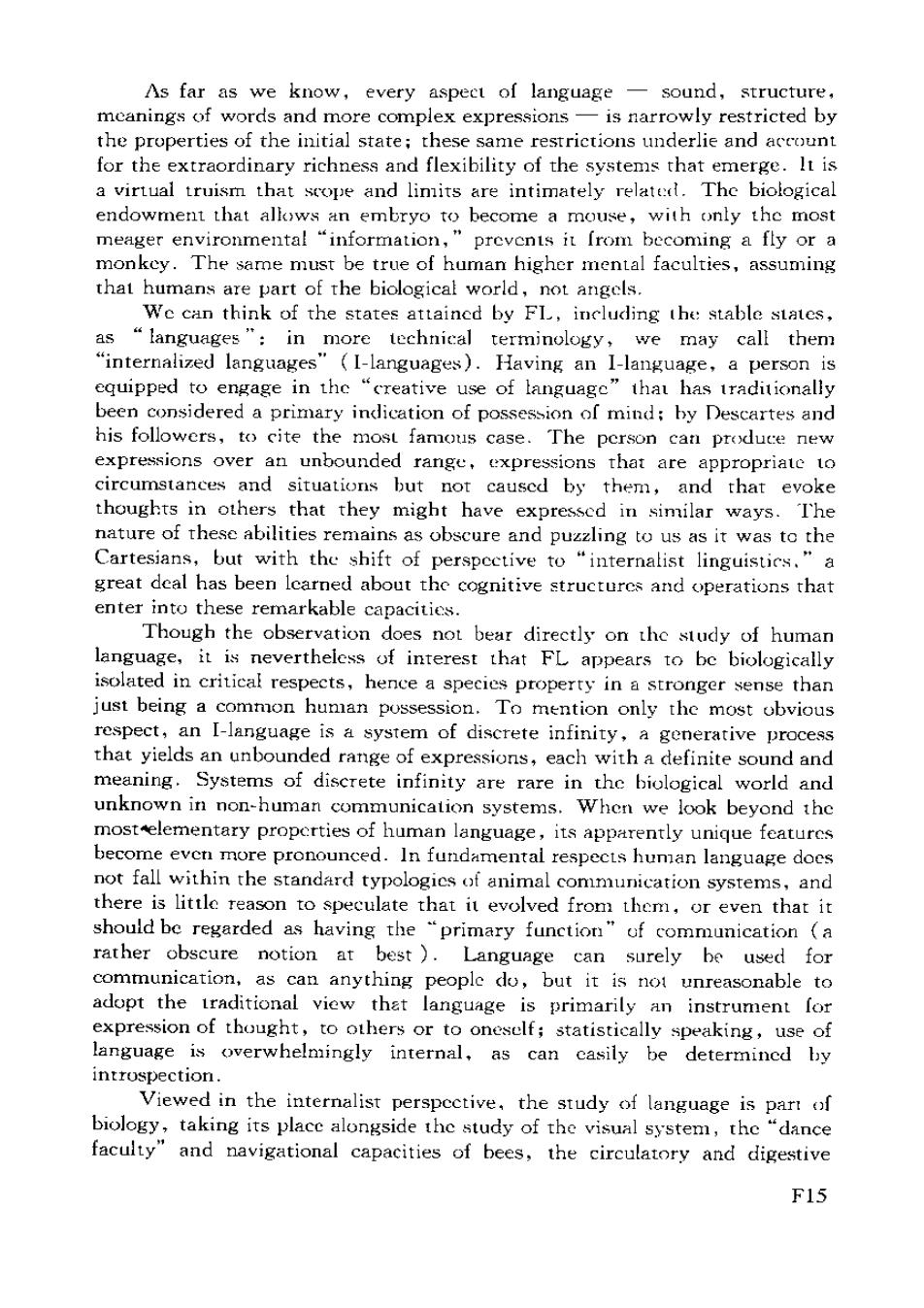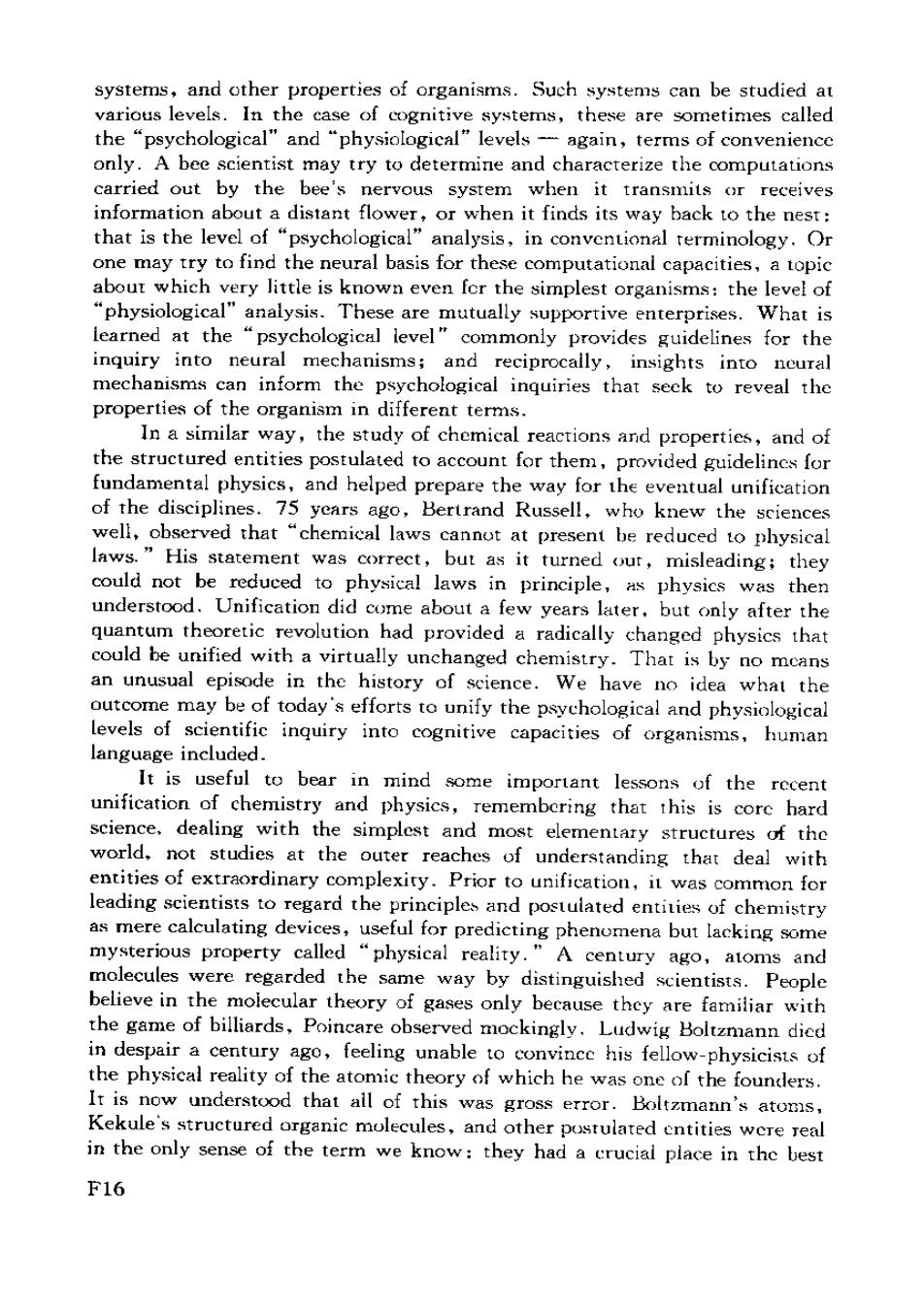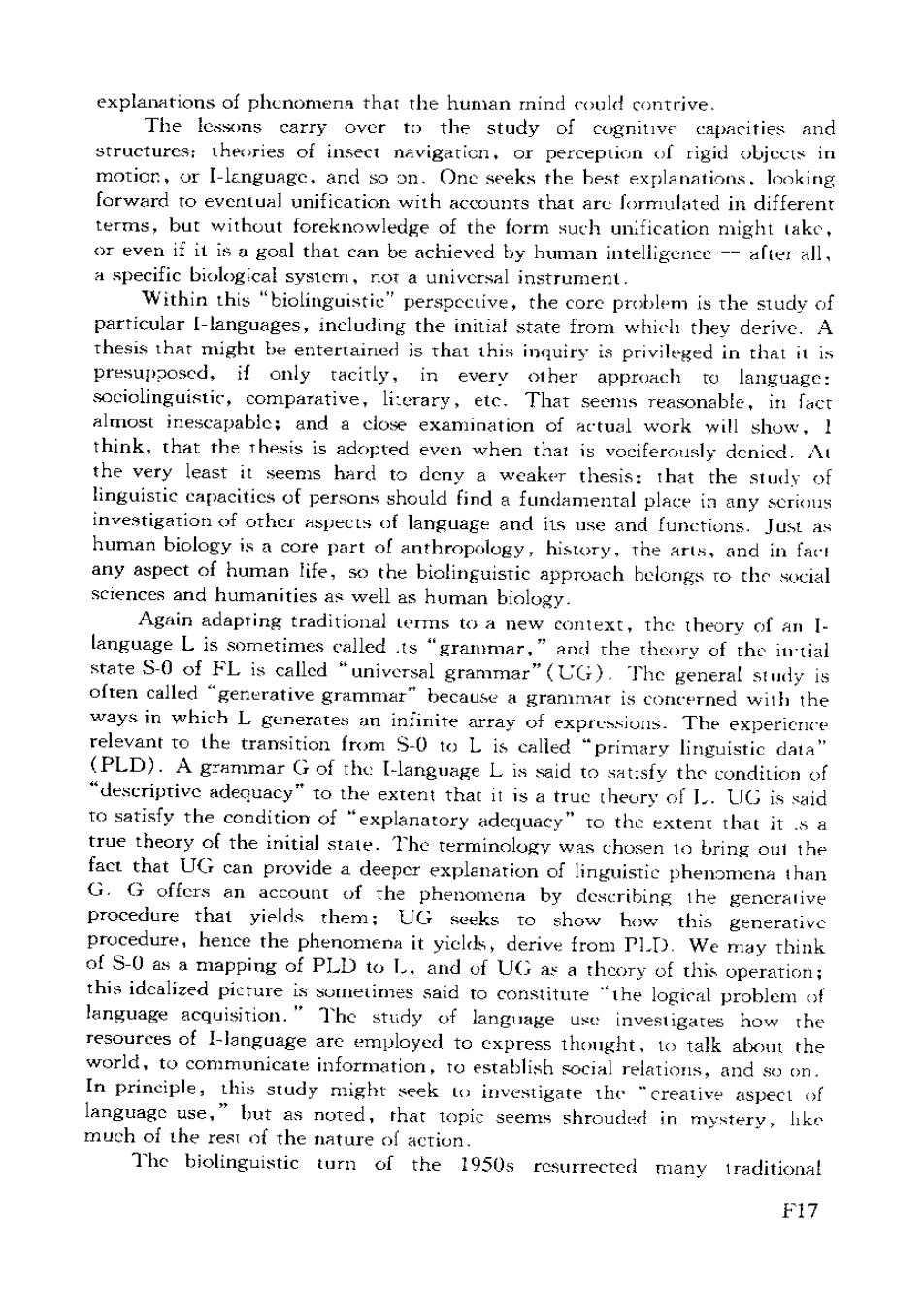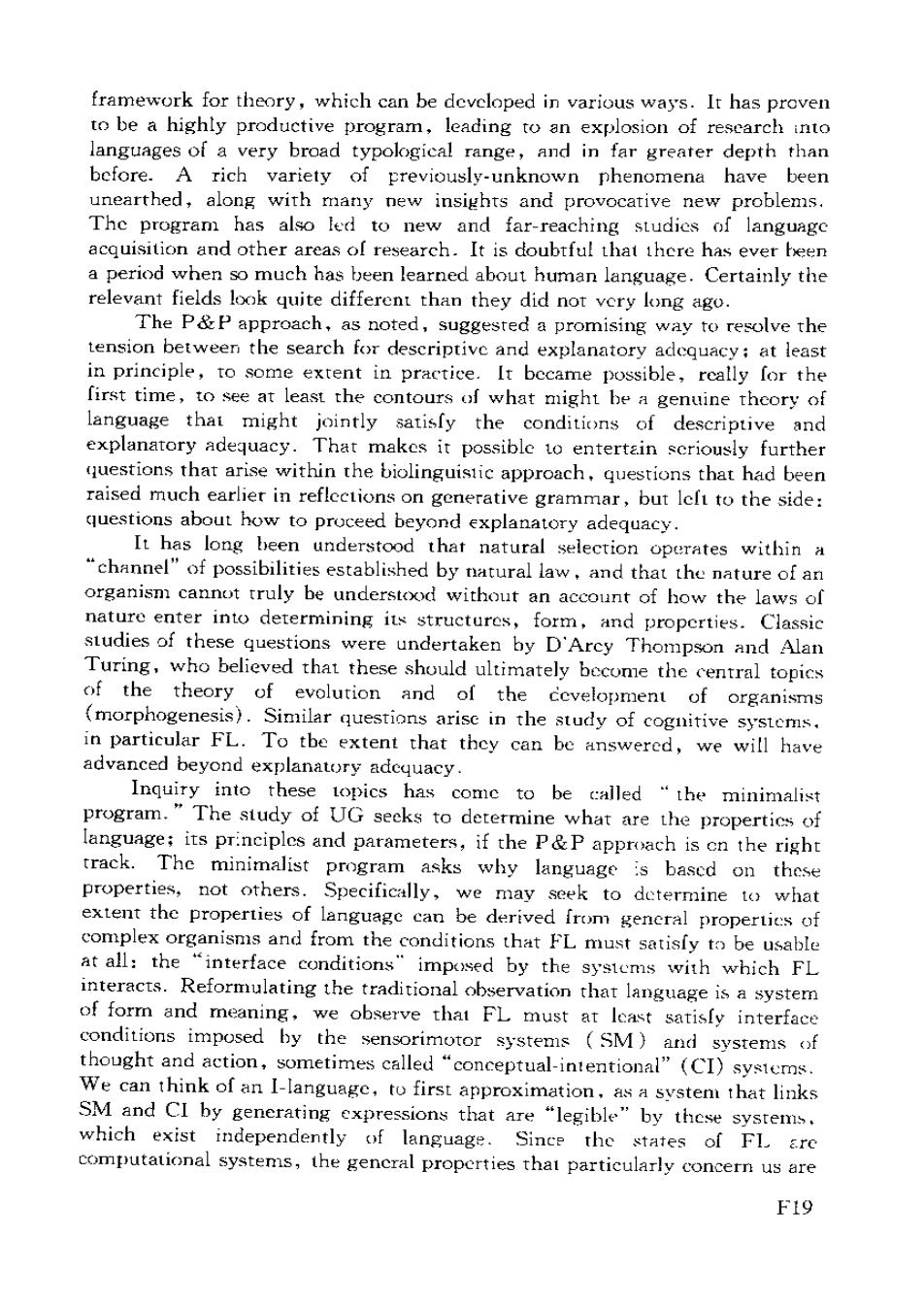
As far as we know,every aspect of language -sound,structure, meanings of words and more complex expressions-is narrowly restricted by the properties of the initial state;these same restrictions underlie and account for the extraordinary richness and flexibility of the systems that emerge.It is a virtual truism that scope and limits are intimately related.The biological endowment that allows an embryo to become a mouse,with only the most meager environmental "information,"prevents it from becoming a fly or a monkey.The same must be true of human higher mental faculties,assuming that humans are part of the biological world,not angels. We can think of the states attained by FL,including the stable states, as "languages":in more technical terminology,we may call them "internalized languages"(I-languages).Having an I-language,a person is equipped to engage in the "creative use of language"that has traditionally been considered a primary indication of possession of mind;by Descartes and his followers,to cite the most famous case.The person can produce new expressions over an unbounded range,expressions that are appropriatc to circumstances and situations but not caused by them,and that evoke thoughts in others that they might have expressed in similar ways.The nature of these abilities remains as obscure and puzzling to us as it was to the Cartesians,but with the shift of perspcctive to "internalist linguistics."a great deal has been lcarned about the cognitive structurcs and operations that enter into these remarkable capacities. Though the observation does not bear directly on the study of human language,it is nevertheless of interest that FL appears to be biologically isolated in critical respects,hence a species property in a stronger sense than just being a common human possession.To mention only the most obvious respect,an I-language is a system of discrete infinity,a generative process that yields an unbounded range of expressions,each with a definite sound and meaning.Systems of discrete infinity are rare in the biological world and unknown in non-human communicalion systems.When we look beyond the most elementary properties of human language,its apparently unique features become even more pronounced.In fundamental respects human language does not fall within the standard typologics of animal communication systems,and there is little reason to speculate that it evolved from them,or even that it should be regarded as having the "primary function"of communication (a rather obscure notion at best )Language can surely be used for communication,as can anything people do,but it is not unreasonable to adopt the traditional view that language is primarily an instrument for expression of thought,to others or to oneself;statistically speaking,use of language is overwhelmingly internal,as can casily be determined by introspection. Viewed in the internalist perspcctive,the study of language is part of biology,taking its place alongside the study of the visual system,the "dance faculty"and navigational capacities of bees,the circulatory and digestive F15

systems,and other properties of organisms.Such systems can be studied at various levels.In the case of cognitive systems,these are sometimes called the "psychological"and "physiological"levels-again,terms of convenience only.A bee scientist may try to determine and characterize the computations carried out by the bee's nervous system when it transmits or receives information about a distant flower,or when it finds its way back to the nest: that is the level of "psychological"analysis,in conventional terminology.Or one may try to find the neural basis for these computational capacities,a topic about which very little is known even fcr the simplest organisms:the level of "physiological"analysis.These are mutually supportive enterprises.What is learned at the "psychological level"commonly provides guidelines for the inquiry into neural mechanisms;and reciprocally,insights into ncural mechanisms can inform the psychological inquiries that seck to reveal the properties of the organism in different terms. In a similar way,the study of chemical reactions and properties,and of the structured entities postulated to account for them,provided guidelines for fundamental physics,and helped prepare the way for the eventual unification of the disciplines.75 years ago,Bertrand Russell,who knew the sciences well,observed that "chemical laws cannot at present be reduced to physical laws.His statement was correct,but as it turned out,misleading;they could not be reduced to physical laws in principle,as physics was then understood.Unification did come about a few years later,but only after the quantum theoretic revolution had provided a radically changed physics that could be unified with a virtually unchanged chemistry.That is by no mcans an unusual episode in the history of science.We have no idea what the outcome may be of today's efforts to unify the psychological and physiological levels of scientific inquiry into cognitive capacities of organisms,human language included. It is useful to bear in mind some important lessons of the recent unification of chemistry and physics,remembering that this is core hard science,dealing with the simplest and most elementary structures of the world,not studies at the outer reaches of understanding that deal with entities of extraordinary complexity.Prior to unification,it was common for leading scientists to regard the principles and postulated entilies of chemistry as mere calculating devices,useful for predicting phenomena but lacking some mysterious property called "physical reality."A century ago,atoms and molecules were regarded the same way by distinguished scientists.People believe in the molecular theory of gases only because they are familiar with the game of billiards,Poincare observed mockingly.Ludwig Boltzmann died in despair a century ago,feeling unable to convince his fellow-physicists of the physical reality of the atomic theory of which he was one of the founders. It is now understood that all of this was gross error.Boltzmann's atoms, Kekule's structured organic molecules,and other postulated cntities were real in the only sense of the term we know:they had a crucial place in the best F16

explanations of phenomena that the human mind could contrive. The lessons carry over to the study of cognitive capacities and structures:theories of insect navigaticn,or perception of rigid objects in motior,or I-languagc,and so on.One seeks the best explanations.looking forward to eventual unification with accounts that are formulated in different terms,but without foreknowledge of the form such unification might take, or even if it is a goal that can be achieved by human intelligence--after all, a specific biological sysicm,not a universal instrument. Within this "biolinguistic"perspcctive,the core problem is the study of particular I-languages,including the initial state from which they derive.A thesis that might be entertained is that this inquiry is privileged in that it is presupposed,if only tacitly,in every other approach to language: sociolinguistic,comparative,literary,etc.That seems reasonable,in fact almost inescapablc;and a close examination of actual work will show.I think,that the thesis is adopted even when that is vociferously denied.At the very least it seems hard to deny a weaker thesis:that the study of linguistic capacitics of persons should find a fundamental place in any scrious investigation of other aspects of language and its use and functions.Just as human biology is a core part of anthropology,history,the arts,and in fact any aspect of human life,so the biolinguistic approach belongs to the social sciences and humanities as well as human biology. Again adapting traditional terms to a new context,the theory of an I- language L is sometimes calledts "grammar,"and the theory of the iutial state S-0 of FL is called "universal grammar"(UG).The general study is often called "generative grammar"because a grammar is concerned with the ways in which L generates an infinite array of expressions.The expericnce relevant to the transition from S-0 to L is called "primary linguistic data" (PLD).A grammar G of the:I-language L is said to sat:sfy the condition of "descriptive adequacy"to the extent that it is a true theory of I..UG is said to satisfy the condition of "explanatory adequacy"to the extent that it .s a true theory of the initial state.The terminology was chosen 1o bring out the fact that UG can provide a deeper explanation of linguistic phenomena than G.G offers an account of the phenomena by describing the gencrative procedure that yields them;UG seeks to show how this generative procedure,hence the phenomena it yiclds,derive from PLD).We may think of S-0 as a mapping of PLD to I..and of UG as a theory of this operation; this idealized picture is sometimes said to constitute "the logical problem of language acquisition."The study of language use investigates how the resources of I-language are employed to express thought,to talk about the world,to communicate information,to establish social relations,and so on. In principle,this study might seek to investigate the "creative aspect of language use,but as noted,that topic seems shrouded in mystery,hke much of the rest of the nature of action. The biolinguistic turn of the 1950s resurrected many traditional F17

questions,but was able to approach them in new ways.with the help of intellectual tools that had not previously been available:in particular,a clear understanding of the nature of recursive processes,generative procedures that can characterize an infinity of objects (in this case,expressions of L)with finite means the mechanisms of L).As soon as the inquiry was seriously undertaken,it was discovered that traditional grammars and dictionaries.no matter how rich and detailed,did not address central questions about linguis ic expressions.They basically provide "hints"that can be used by somcone cquipped with FL and some of its states,but leave the nature of these systems unexamined.Very quickly,vast ranges of new phenomena were discovered,along with new problems,and sometimes at least partial answers. It was recognized very soon that there is a serious tension between the scarch for descziptive and for explanatory adequacy.The former appears to lead to very intricate rule systems,varying among languages and among constructions o:a particular language.But this cannot be correct,since each language is attained with a common FL on the basis of PLD providing l.ttle information about these rules and constructions. The dilemma led to efforts to discover general propertics of rule systems that can be extracted from particular grammars and attributed to UG,leaving a residue simple enough to be attainable on the basis of PLD.About 25 years ago,these efforts converged in the so-called "principles and parameters' (P&P)approach,which was a radical break from traditional ways of looking at language.The P&P approach dispenses with the rules and constructions that constituted the framework for traditional grammar,and were taken over,pretty much,in early generative grammar.The relative clauses of Hungarian and verb phrases of Japanese exist,but as taxonomic artifacts, rather like "terrestrial mammal"or "creature that flies.The rules for forming them are decomposed into principles of UG that apply to a wide variety of traditional constructions.A particular language L is determined by fixing the values of a finite number of "parameters"of S-0:Do heads of phrases precede or follow their complements?Can certain categories be null (lacking phonetic realization)?Etc.The parameters must be simple enough for values to be set on the basis of restricicd and easily obtained data. Language acquisition is the process of fixing these values.The parameters can be thought of as "atoms"of language,to borrow Mark Baker's metaphor. Each human language is an arrangement of these atoms,determined by assigning values to the parameters.The fixed principles are available for constructing expressions however the atoms are arranged in a particular I- language.A major goal of research,then,is to discover something like a "periodic table"that will explair.why only a very small fraction of imaginable linguistic systems appear to be instantiated,and attainable in the normal way. Note that the P&P approach is a program,not a specific theory;it .s a F18

framework for theory,which can be devcloped in various ways.It has proven to be a highly productive program,leading to an explosion of research into languages of a very broad typological range,and in far greater depth than before.A rich variety of previously-unknown phenomena have been unearthed,along with many new insights and provocative new problems. The program has also led to new and far-reaching studies of language acquisition and other areas of research.It is doubtful that there has ever been a period when so much has been learned about human language.Certainly the relevant fields look quite different than they did not very long ago. The P&P approach,as noted,suggested a promising way to resolve the tension between the search for descriptive and explanatory adequacy at least in principle,to some extent in practice.It became possible,really for the first time,to see at least the contours of what might be a genuine theory of language that might jointly satisfy the conditions of descriptive and explanatory adequacy.That makes it possible to entertain scriously further questions that arise within the biolinguistic approach,questions that had been raised much earliet in reflections on generative grammar,but left to the side: questions about how to proceed beyond explanatory adequacy. It has long been understood that natural selection operates within a "channel"of possibilities established by natural law,and that the nature of an organism cannot truly be understood without an account of how the laws of nature enter into determining its structures,form,and properties.Classic studies of these questions were undertaken by D'Arcy Thompson and Alan Turing,who believed that these should ultimately become the central topics of the theory of evolution and of the cevelopment of organisms (morphogenesis).Similar questions arisc in the study of cognitive systems. in particular FL.To tbe extent that they can be answered,we will have advanced beyond explanatory adequacy. Inquiry into these topics has come to be called "the minimalist program.The study of UG seeks to determine what are the propertics of language;its principles and parameters,if the P&P approach is cn the right track.The minimalist program asks why language is based on these properties,not others.Specifically,we may seek to dctermine to what extent the properties of language can be derived from general propertics of complex organisms and from the conditions that FL must satisfy to be usable at all:the "interface conditions"imposed by the systems with which FL interacts.Reformulating the traditional observation that language is a system of form and meaning,we observe that FL must at least satisly interface conditions imposed by the sensorimotor systems (SM)and systems of thought and action,sometimes called "conceptual-intentional"(CI)systems. We can think of an I-language,to first approximation,as a system that links SM and CI by generating expressions that are "legible"by these systems. which exist independently of language.Since the states of FL are computational systems,the gencral properties that particularly concern us are F19